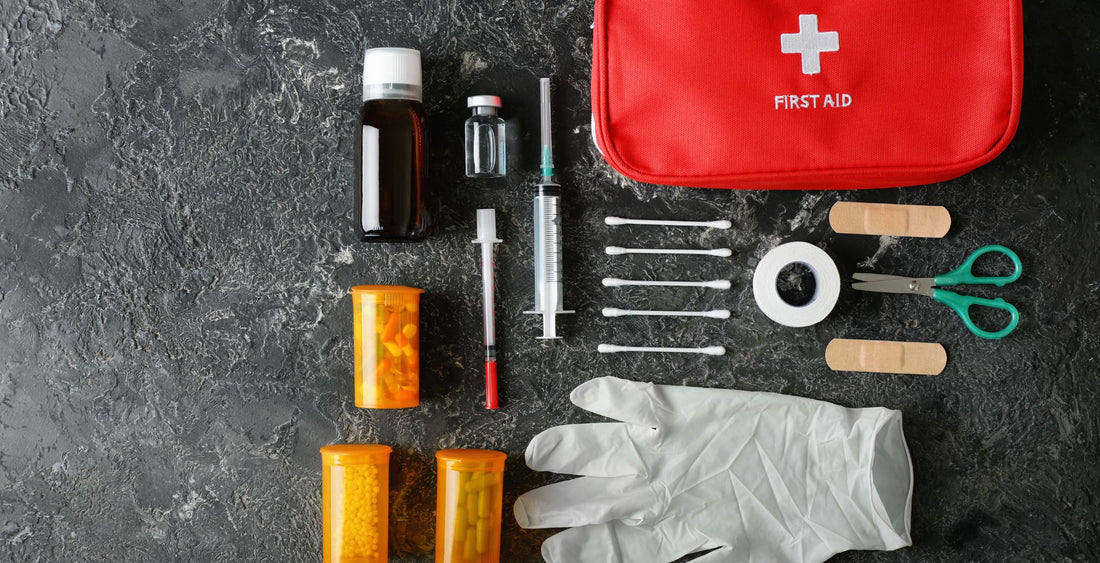
Essential First Aid Treatment Steps - Your basic guide to immediate care
Share
In our day-to-day lives, it’s possible we’ll encounter situations that call for immediate action to provide first aid treatment. And when it comes to first aid treatment a little knowledge can go a long way toward minimising the extent of injuries when they occur.
In this brief guide, we'll walk you through the essential first aid treatment steps for various common emergencies. We will also highlight some products available from Harmless.nz that can be super useful items to include in your first aid kit so you are ready if needed. So, let's dive in and explore the key steps to handle situations like dislocations, fractures, head injuries, wounds, burns, and shock effectively.
1. First Aid Treatment for Shock

Shock is a potentially life threatening condition that can result from a sudden traumatic experience (e.g. accident or injury) or severe emotional stress (e.g. loss of a loved one). Recognising the symptoms and providing swift first aid treatment is essential. Here are the steps you should follow:
1. Ensure Safety: First, ensure the area is safe for both the victim and yourself.
2. Call for Help: Dial 111 emergency services if the situation is severe. Don't hesitate.
3. Comfort and Reassure: Keep the victim calm, laying them down with their legs slightly elevated. Offer reassurance.
4. Keep Warm: Cover the person with an emergency blanket or clothing to maintain body temperature.
2. Dislocation First Aid Treatment

Dislocations are joint injuries that require immediate attention. Here's a brief guide on how to provide first aid treatment for dislocations:
1. Immobilise the Joint: Help the victim remain as still as possible, avoiding any movement of the affected joint. The use of a triangular bandage is often a good way to achieve this.
2. Apply Cold Packs: Use cold packs to help reduce swelling and alleviate pain.
3. Seek Medical Help: It's crucial to consult a medical professional to address the dislocation effectively. DO NOT try to put the joint back into place as you could cause a lot more harm in doing so.
3. First Aid Treatment for Fractures

Fractures, or broken bones, can be excruciating and demand careful handling. Here's a brief guide on providing first aid treatment for fractures:
1. Immobilise the Fracture: Stabilise the broken bone using a splint or any rigid material available. It may be beneficial to also apply a triangular bandage if the limb is an arm to help reduce movement.
2. Elevate the Injured Limb: If possible, elevate the injured limb to reduce swelling.
3. Apply Cold Packs: Use cold packs to help alleviate pain and reduce swelling in the affected area.
4. Seek Medical Help: A medical professional should evaluate and treat the fracture.
4. Head Injury - First Aid Treatment

Head injuries can range from mild concussions to severe trauma. Quick first aid treatment is crucial and in most instances the guidance of a medical professional is required as most first raiders will not have the skills to recognise when an internal injury has occurred. Here's what to do:
1. Protect the Head: Ensure the head is still and supported to prevent further injury.
2. Monitor Vital Signs: Keep an eye on the victim's breathing and pulse. Be prepared to perform CPR if necessary.
3. Call for Help: If there is any chance of internal injuries or the head injury is significant, call emergency services 111 immediately.
5. First Aid Treatment for Wounds

Cuts and wounds are common injuries that require proper first aid treatment. Follow these steps:
1. Cleanse the Wound: Use a gauze swab and saline solution or an alcohol wipe or antiseptic wipe to gently clean the wound.
2. Apply Pressure: Use a sterile wound dressing or combine dressing to apply gentle pressure to stop bleeding.
3. Cover the Wound: Cover the wound with an adhesive dressing or plaster, or if it is a larger wound, cover the wound dressing with a crepe bandage, cohesive bandage or to keep it clean and protected.
4. Seek Medical Attention: If the wound is deep, large, or caused by a dirty object, seek professional medical care as soon as possible.
6. Burn First Aid Treatment

Burns can vary in severity, and the first aid treatment depends on the degree of the burn. Here's a brief guide for minor burns (for more severe burns seek medical advice ASAP):
1. Cool the Burn: Use cool, not cold, water to reduce the temperature of the burn and then apply a cooling burn gel which are specifically designed for burns and are therefore ideal for this purpose.
2. Cover the Burn: Apply a non-adhesive wound dressing and/or a sterile non-stick bandage to protect the burn from infection.
3. Pain Management: Over-the-counter pain relievers can help alleviate pain.
4. Seek Medical Help: For severe burns or burns on the face, hands, feet, or genitals, call emergency services on 111 and ask for an ambulance or consult a medical professional straight away.
In summary, being prepared with the right knowledge and the appropriate first aid supplies can make a significant difference in various emergency situations. Harmless.nz offers a variety of high-quality first aid products, from sterile dressings to emergency blankets, that can enhance your first aid kit and have you ready for whatever life throws at you. Remember that while this guide provides basic initial first aid steps, professional medical attention is always necessary for serious injuries. Stay safe and be prepared to save lives with essential first aid treatment steps.
For more first aid tips and product recommendations, visit harmless.nz where your safety and wellbeing matters.
